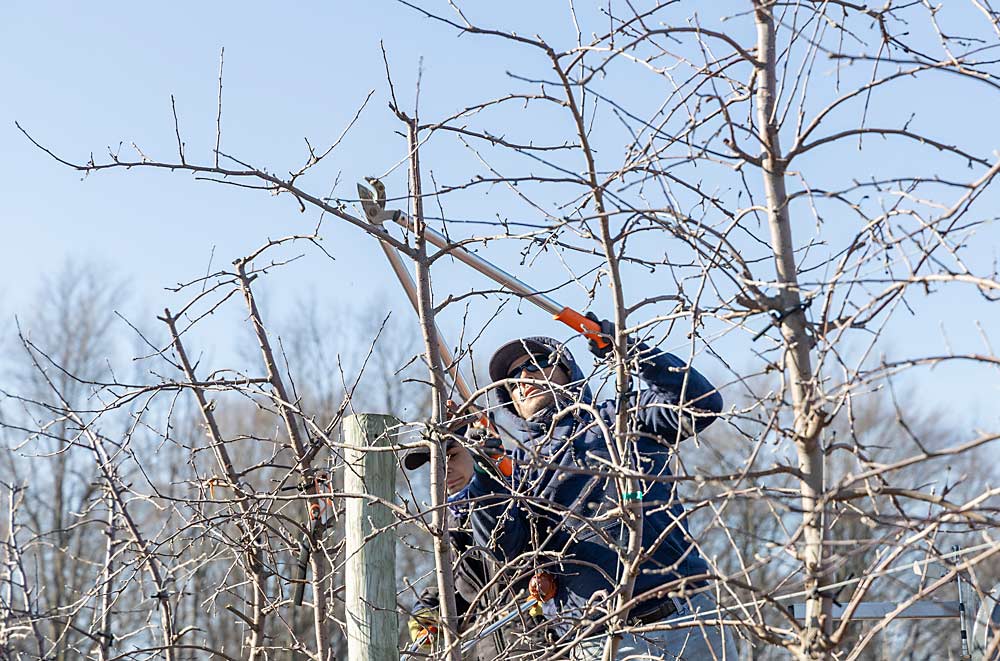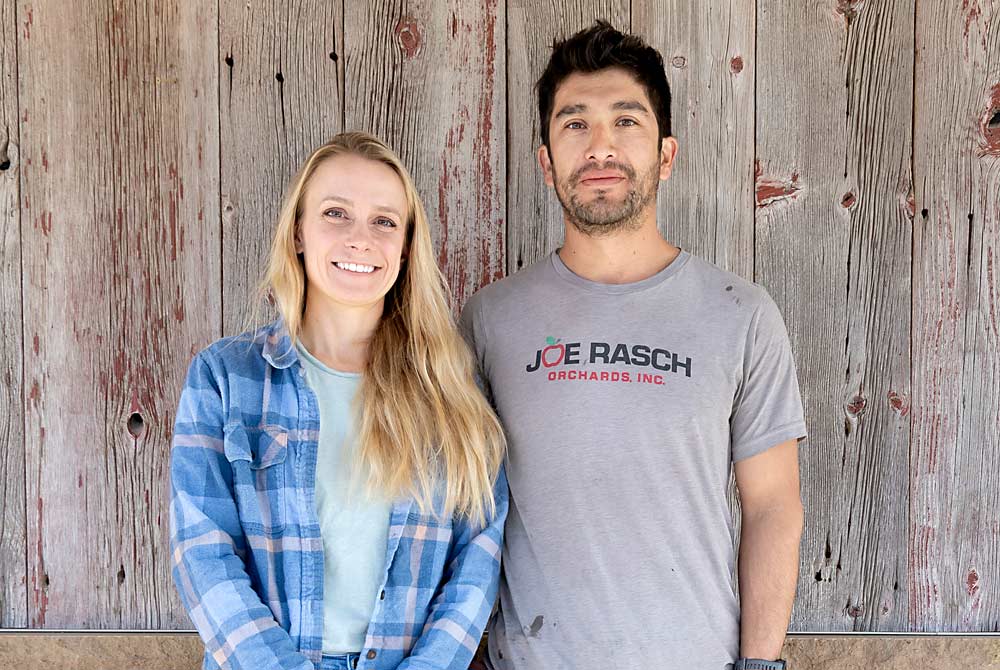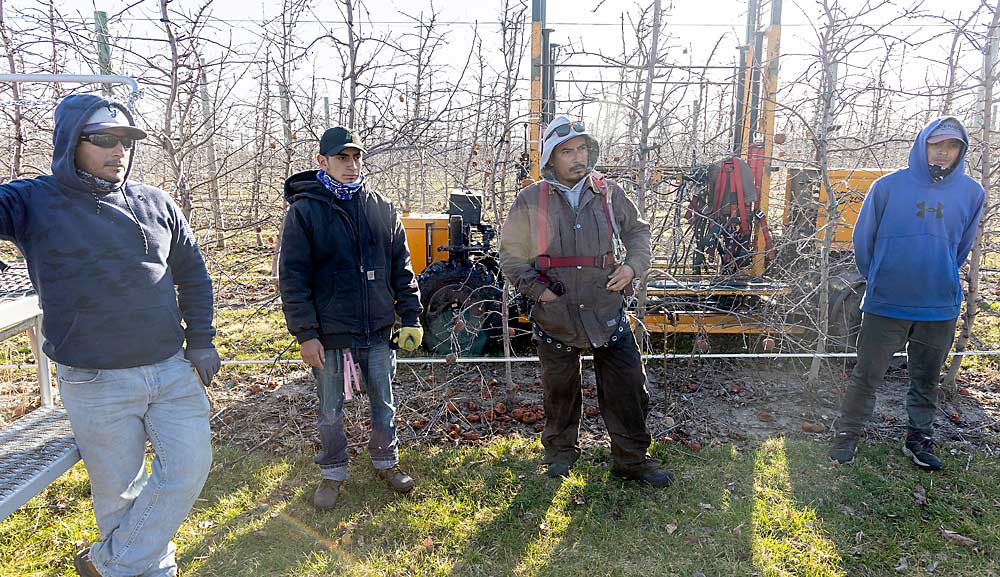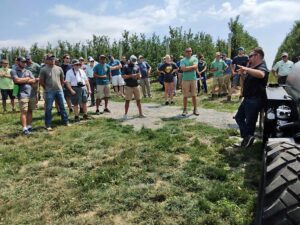—story and photos by Matt Milkovich

Growers in Michigan’s Fruit Ridge orchard region north of Grand Rapids started this growing season with plenty to worry about. Markets were still glutted with apples after a big 2023 crop, and prices were low. Trees were budding early after an extremely warm winter, and everyone was anticipating a long spring of potential crop-killing freezes.
But at Joe Rasch Orchards and other apple farms that hire H-2A workers, there were more existential worries as well. If the federal guest-worker program’s wage rate continues to skyrocket and the price of apples continues to decline, many of those orchards won’t be around much longer, said Katie and Manuel Vargas, who run the family orchard with Katie’s parents, Joe and Mary Rasch.
During a March visit with Good Fruit Grower, Katie, who’s become something of an unofficial spokesperson for the Michigan apple industry, said that if the H-2A program’s Adverse Effect Wage Rate — meant to protect domestic workers from “adverse effects” caused by the presence of H-2A workers — isn’t fixed soon, or at least frozen in place, there will be a wave of “For Sale” signs going up on the Ridge in the next year or two.
She’s not the only one sounding the alarm.
“The Michigan apple industry is at risk,” said Diane Smith, executive director of the Michigan Apple Committee. “I’m hearing from growers all over Michigan, telling me their farms won’t survive.”
Katie said that growers are used to periods of low-priced fruit; combined with a Michigan AEWR of $18.50 per hour in 2024, however, the situation has become dire. Industry groups across the country are pushing for government relief. U.S. Rep. John Moolenaar, whose district includes the Fruit Ridge, introduced a bill in January that would freeze the AEWR through 2025, but the industry also wants a long-term solution that would require a congressional overhaul of the H-2A program.
“I think it can get solved,” she said. “I just don’t know if it’s going to be fast enough.”

Joe Rasch Orchards was one of the first Michigan apple employers to hire H-2A workers in 2014, as part of a pilot program organized by Michigan Farm Bureau. At that time, Michigan’s AEWR was $11.49 per hour. After learning from that experience, Katie spent the next five years working for Great Lakes Ag Labor Services, an agency created by Michigan Farm Bureau to help farmers navigate the H-2A program.
She said the growers she worked with had a “love/hate” relationship with H-2A. Some of the program’s red tape has been streamlined over the years, but growers are still dealing with multiple federal and state agencies and a lot of paperwork. On the other hand, H-2A provided them with a skilled, reliable workforce that showed up every year.
“For a time, it let (growers) see a future,” Katie said. “You’re getting fruit off on time, getting better packouts, better quality — but there was always an underlying concern about the wage getting to a point where it’s unsustainable. That’s where they are now.”
Smith said Michigan’s AEWR has gone up 61 percent in the past decade. The state’s apple growers hired an estimated 5,200 H-2A workers in 2023.
Driving through the family orchard, Manuel Vargas said input costs in general have gone up, while apple prices are lower than they were three years ago. As he drove by a block of old, freestanding trees, Empire and Red Delicious, Manuel said he would like to pull them out and put in a more modern planting, but they can’t afford it.
A crew of H-2A workers took a break from pruning to answer a few questions. Katie and Manuel translated. The pruners said the H-2A program provides them with good work, and they want the orchard to survive so the work can continue.
“We need these people,” Manuel said. “They’re not taking jobs from anybody.”

Local people rarely apply for orchard work, and Joe Rasch Orchards spent years relying on migrant labor. That changed after 2012, when an early spring followed by freeze events virtually wiped out Michigan’s apple crop. They didn’t have much work to offer that year, and not enough workers showed up the following year. That’s when they decided to try H-2A. Like a lot of orchards, they’ve come to rely on H-2A workers to survive, Katie said.
Last year, they hired about 75 H-2A workers to manage their 450 acres of apples, and about 25 H-2A workers for the packing house, where they work alongside domestic workers, she said.
Katie has used her H-2A knowledge to petition lawmakers and officials in Washington, D.C. She was there again in March, seeking program changes alongside the U.S. Apple Association.
She encourages other growers to get involved, too. During the Michigan Pomesters’ Ridgefest last summer, she told the gathering that industry messages are more effective if they come directly from growers.
“There’s a lot of loud voices that say (H-2A is) not a good program, but I know that’s not the situation on our farms,” she said. “If we don’t make our stories heard, the only stories people will hear are the bad ones. And that becomes their truth.” •








Leave A Comment